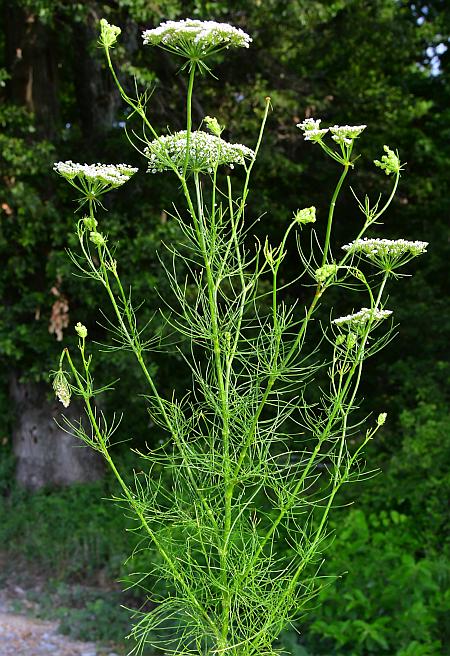Ptilimnium nuttallii (DC.) Britton
Ozark Mock Bishop's Weed

Native
CC = 4
CW = -3
MOC = 29
© SRTurner
Ptilimnium nuttallii (DC.) BrittonOzark Mock Bishop's Weed | |
 |
Native CC = 4 CW = -3 MOC = 29 |
© SRTurner |
|
Family - Apiaceae Habit - Annual forb, from fibrous roots and sometimes rhizomes.
Stems - Ascending to erect, to 70 cm, sometimes branched, glabrous.
Leaves - Alternate, dissected. Leaf base sheaths only slightly inflated. Blades 3-10 cm long, pinnately 2-3 times compound, the main segments alternate or opposite along the rachis, but not whorled, the ultimate divisions threadlike and 4-60 mm long.
Inflorescence - Terminal compound umbels. Involucre of 6-15 bracts, these 4-15 mm long, mostly unbranched. Rays 15 to numerous, 1.0-3.5 cm long. Flowers mostly numerous in each umbellet, the stalks 3-8 mm long. Involucel of narrowly lanceolate bractlets.
Flowers - Sepals 5, minute, narrowly triangular scales. Petals obovate, often appearing shallowly notched, but narrowed or tapered abruptly to a short, slender tip (which is usually folded back over the petal), white. Ovaries glabrous. Styles at fruiting 0.5-1.0 mm long, usually curved downward. Stamens 5, alternating with petals. Filaments white, 0.8mm long, glabrous. Anthers pinkish-rose, 0.3 mm long. Ovary inferior, 2-locular, with one ovule per locule.
Fruits - Schizocarps 1.0-1.5 mm long, with relatively broad, conspicuous, straw-colored to light yellowish brown surfaces between the lateral ribs and the commissures, the ribs similarly colored, the areas between the ribs with reddish brown oil tubes. Mericarps with 5 rounded ribs.
Flowering - June - August. Habitat - Bottomland prairies, moist depressions of upland prairies and glades, streambanks, fens, swamps, ditches, roadsides, and railroads. Origin - Native to the U.S. Lookalikes - Other species of Ptilimnium. Other info. - This species is easy to ID in the field because of its highly dissected leaves, umbels of white flowers, and wet habitat. It is differentiated from the other Missouri species of Ptilimnium by its involucral bracts, which are unbranched, and by its leaves, which have a one-sided (not whorled) attachment of leaflets to the main leaf rachis (see photo above). The terminal, threadlike leaf segments also tend to be quite long. The plant is intermediate in stature between P. costatum, which is taller, and P. capillaceum, which is shorter. The plant is scattered in Missouri with populations clustered near the Bootheel and also in the southwest corner of the state. Beyond Missouri its range is restricted to a few states in the south-central part of the continental U.S. Photographs taken at the Dorris Creek Prairie Conservation Area, Barton County, MO., 7-28-00, and at Bethel Prairie, Barton County, MO., 7-4-03 (DETenaglia); also near Neelyville, Butler County, MO, 6-16-2023 (SRTurner). |